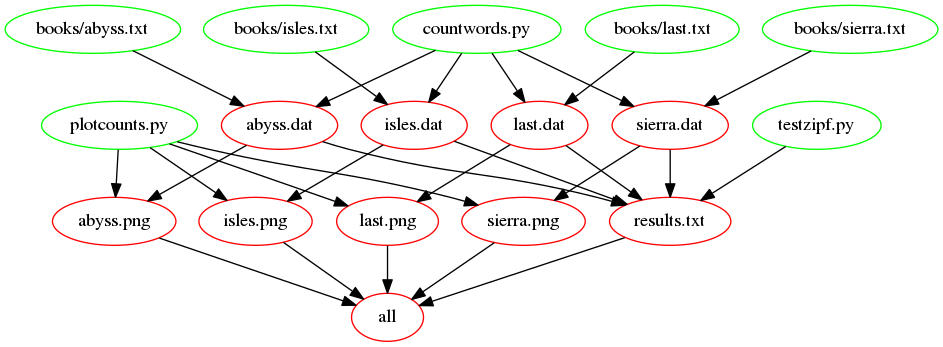Conclusion
Last updated on 2025-04-16 | Edit this page
Estimated time: 35 minutes
Overview
Questions
- What are the advantages and disadvantages of using tools like SCons?
Objectives
- Understand advantages of automated build tools such as SCons.
Automated build tools such as SCons can help us in a number of ways. They help us to automate repetitive commands, hence saving us time and reducing the likelihood of errors compared with running these commands manually.
They can also save time by ensuring that automatically-generated artifacts (such as data files or plots) are only recreated when the files that were used to create these have changed in some way.
Through their notion of targets, sources, and actions, they serve as a form of documentation, recording dependencies between code, scripts, tools, configurations, raw data, derived data, plots, and papers.
Creating PNGs
Add new rules, update existing rules, and add new variables to:
- Create
.pngfiles from.datfiles usingplotcounts.py. - Update the default target to include the
.pngfiles. - Remove all auto-generated files (
.dat,.png,results.txt).
This SConstruct file and this Python module contain a simple solution to this challenge.
Can you think of a way to reduce duplication in
count_words and plot_counts functions?
To remove all targets, use the SCons special ‘.’ target
and the --clean flag.
The following figure shows the dependencies involved in building the
‘.’ or ‘all’ target, once we’ve added support for
images:

Creating an Archive
Often it is useful to create an archive file of your project that includes all data, code and results. An archive file can package many files into a single file that can easily be downloaded and shared with collaborators. We can add steps to create the archive file inside the SConstruct itself so it’s easy to update our archive file as the project changes.
Edit the SConstruct to create an archive file of your project. Add new rules, update existing rules and add new variables to:
Create a
zipf_analysis.tar.gzarchive including our code, data, plots, the Zipf summary table, the SConstruct file with the SConsTarbuilder.Update the default targets list so that it creates
zipf_analysis.tar.gz.Print the values of any additional variables you have defined when
scons --variablesis called.
This SConstruct file and this Python module contain a simple solution to this challenge.
Archiving the SConstruct file
Why does the SCons task for the archive directory add the SConstruct to our archive of code, data, plots and Zipf summary table?
Our code files (countwords.py,
plotcounts.py, testzipf.py) implement the
individual parts of our workflow. They allow us to create
.dat files from .txt files, and
results.txt and .png files from
.dat files. Our SConstruct file, however, documents
dependencies between our code, raw data, derived data, and plots, as
well as implementing our workflow as a whole.
- SCons and SConscript files save time by automating repetitive work, and save thinking by documenting how to reproduce results.
